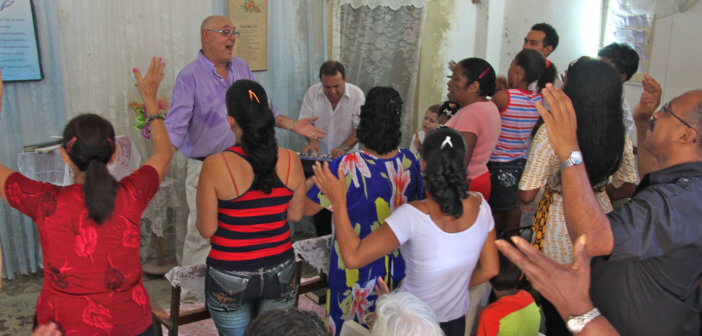The growing Latino and Latina population in the United States is transforming the religious landscape, reshaping virtually every Christian tradition. Drawing on the work of Juan Francisco Martínez, a scholar of the history of Latino/a Protestantism, Lovett Weems reports on trends in Latino/a ministry that are vital to any congregational or denominational leader with a heart for the newcomer in our midst.
The growing Latino and Latina population in the United States is transforming the religious landscape in ways that will shape virtually all Christian traditions as this century unfolds. These communities, characterized by a shared language and culture, are not new to the United States or to its religious life. The difference today is the size and growth of the Latino/a community.
Juan Francisco Martínez, professor of Hispanic studies and pastoral leadership at Fuller Theological Seminary, has written extensively on Protestant efforts to reach Latino/a people in the U.S. In 2008 he published Walk with the People: Latino Ministry in the United States, available in English and Spanish (Abingdon, 2008; Wipf and Stock, 2016). His latest and more extensive book is The Story of Latino Protestants in the United States (Eerdmans, 2018). Martinez gives a perspective on past and present realities and provides lessons for planning for the future.
Those who do not come out of the Latino/a community need an orientation to basic social, cultural, and religious realities that can inform any new ministries. The profound diversity of the Latino/a people in the U.S. is one of those realities. There are no one-size-fits-all answers. But there are general principles and understandings that make mutual ministry more likely to occur.
Observations about Latino/a church life
The strong Catholic tradition of Latinos and Latinas, especially among those with a Mexican heritage, is well known. At least one-third of U.S. Catholics have a Spanish-speaking heritage. There is something of a generational movement toward Protestantism; those who have been in the U.S. for three or four generations are more likely to be Protestant.
Today virtually every denomination in the U.S. has an outreach to the Latino/a community. Some of these have long traditions, while others began only recently. In addition, there are churches with no affiliation to U.S. denominations. These congregations, which are often Pentecostal, represent some of the greatest non-Catholic growth.
While a growing number of Latinos and Latinas attend predominantly majority population churches, the largest number by far worship in churches rooted in their own language and culture. A Pew study found that most of these churches have three characteristics: services in Spanish, Latino/a pastors, and a strong Latino/a presence among its members. But keep in mind that most of the churches are multicultural, reflecting the diversity among Latino/a people in the U.S.
The Protestant Latino/a congregations mirror other congregations in the U.S. in terms of their small size, usually with fewer than 100 members. (The median worship attendance for all United Methodist churches now is less than 50.) But there are also differences. Their constituencies are often much newer residents and sometimes transient. Various models of ministry have emerged such as multiple churches working together, sharing space with other congregations, and working with congregations in transition.
The most dominant characteristic of Latino/a churches is that they are growing. Not all traditions are growing, but the religious witness of this community is very much alive.
Strengths and challenges of the Latino/a church
It is a mistake for those outside the Latino/a community to ignore the tremendous strengths these Christians bring to any church. They exhibit a high level of religious commitment with what Martínez calls a “live faith in God.” Latino/a congregations have shown a close identification with and service to their communities, great flexibility in adjusting to new realities, a willingness to work very hard, strong family ties, strong mission outreach, and a lively sense of God’s presence in their worship.
Amid their great strengths, there are also great challenges. The Latino/a experience in their communities and within U.S. denominations has been on the peripheries. They also must find ways to function with limited financial resources that make it necessary for many of their clergy to serve bi-vocationally.
What does this mean for the future?
Churches seeking to support outreach to the Latino/a communities need to understand that previous models based on a “deficiency” mindset are not helpful. While the Latino/a communities often do have great needs, they also bring tremendous resources that call for more mutuality and partnership than is often practiced.
Martínez challenges majority population churches to revise some basic assumptions, especially regarding their vision for ministry and their definition of success. For example, a growing number of Latino/a congregations are self-sustaining. However, such a goal may move beyond their reach if self-sustaining is defined using denominational assumptions designed more for majority population congregations. Thriving Latino/a congregations are likely to more closely resemble Latino/a congregations across denominational lines than some other churches in their own denominations. To become and remain viable, Latino/a churches must have the opportunity to develop in ways consistent with their circumstances and culture.
Anglo church leaders have much to learn from history and current circumstances if they want to halt the perpetuation of some unhelpful and insensitive practices and if they want to create a level of positive engagement across cultural and ethnic boundaries that is consistent with faithful and fruitful ministry in the name of Christ.
Related Resources
- “A More Engaging Hospitality,” a Leading Ideas Talks podcast episode featuring Dr. Juan Francisco Martínez
- Building Multicultural Relationships by Mark DeYmaz and Bob Whitesel
- Multicultural Fluency and the Discipline of Dialogue by Curtiss Paul DeYoung






